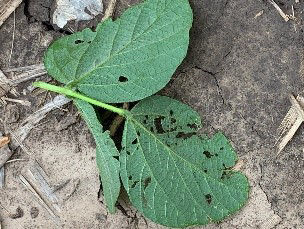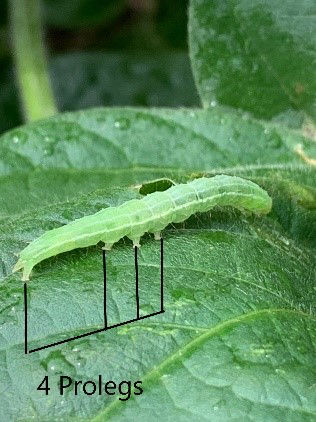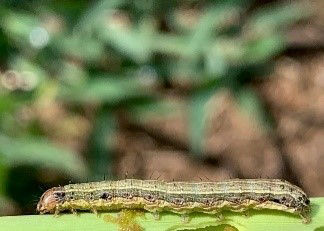Identification and Management of Fall Soybean Caterpillars
September 14, 2021
Fall can bring new insect pests with potentially yield limiting feeding to your soybean crop. Caterpillars can feed on leaf tissue which reduces photosynthesis, or they can feed directly on pods which can reduce yield potential. Scouting these pests, identifying them, determining thresholds, and assessing expected harvest dates are the key to management. Beneficial insects in the field should also be considered as part of the equation as they may reduce these pests or others.
Velvetbean Caterpillar1
Velvetbean caterpillar is a soybean pest that is seen frequently in the Southeastern portion of the United States and less frequently in other areas. The larvae can have multiple colors and change as they progress through its six instar stages. The larvae consume interveinal tissue of soybean plants or other legumes that are alternate hosts (Figure 1). There are a variety of natural enemies that can control populations; therefore, it is important to scout fields frequently to monitor population levels. The prevalent cultural techniques to limit damage is to plant early or utilize trap crops.1

Green Cloverworm2
Green cloverworm are often confused with loopers due to a similar appearance of a green body with white stripes. Green cloverworm larvae have four abdominal prolegs versus loopers which have three (Figure 2). Early instars feed on the underside of the leaf while later instars feed on interveinal tissue leaving a leaf skeleton. Green cloverworm are often controlled by parasites or pathogens, so the amount of feeding and populations should be tracked through the later growing season.2

Soybean Looper3
The soybean looper has a distinct looping or arching motion when moving, hence the name (Figure 3). The larvae are green with white stripes and have three characteristic pairs of prolegs instead of four. The larvae feed lower in the canopy before moving upwards to become more noticeable. Mature soybean plants can tolerate more feeding, though repeated scouting is encouraged as soybean loopers are subject to population control via predatory insects or pathogens.

Soybean Podworm4
Soybean podworms are also known as corn earworm, cotton bollworm, or sorghum headworm. The larvae are not identified by color, rather, they can be identified by the microspines and alternating stripes running lengthwise down the body (Figure 4). Early instar larvae are usually not an economical concern as they feed on blooms and leaves. Later instar larvae begin to eat pods which may, depending on populations, reduce yield potential.

Channel Agronomist
Mark Bartel
Sources:
1Barbara, K.A. Velvetbean caterpillar. Featured Creatures. Entomology & Nematology. University of Florida. https://entnemdept.ufl.edu/creatures/field/velvetbean.htm.
2Obermeyer, J. 2009. Green cloverworm. Field Crops IPM. Purdue University. https://extension.entm.purdue.edu/fieldcropsipm/insects/green-cloverworm.php.
3Jardine, D.J. 2020. Soybean looper. Soybean Pests. Soybean Research & Information Network. https://soybeanresearchinfo.com/soybean-pest/soybean-looper/.
4Kerns, D. and Porter, P. 1970. Soybean podworm. Extension Entomology. Texas A&M University.
Websites verified 7/21/21. 1315_444701